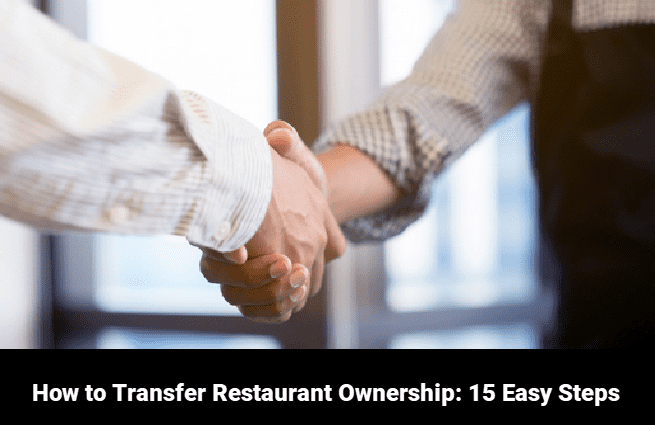How to Transfer Restaurant Ownership 15 Easy Steps

The Complete Guide to Transferring Restaurant Ownership
Hey there,
If you were wondering,
How to Transfer Restaurant Ownership?
You are in the right place.
So, you’ve made it to that point in your career where you have at least one restaurant up and running and are now looking to pass the reins of ownership on to someone else.
This article is here to guide you through the complexities of the process so that your transition goes as smoothly as possible.
Restaurant ownership transfer can be intimidating, but don’t worry – with a bit of preparation; this guide will make sure every step is accounted for.
From financing details to legal paperwork, we tell you all you need to know about transferring restaurant ownership. Let’s get started.
How to transfer restaurant ownership?
How to transfer restaurant ownership? With a bit of preparation and research, you’ll be able to make the transition smooth. Make sure you have all financing details in order, clear any legal paperwork, and take your time in finding the best next owner for your restaurant.
With this guide, you’ll be ready to transfer ownership like a pro.
How to Transfer Restaurant Ownership Made Easy: a Step-by-step Guide
Transferring restaurant ownership doesn’t have to be intimidating! Our step-by-step guide is here to help you through the process. From financing details to legal paperwork, we’ll walk you through every step so that it’s as easy and stress-free as possible. Ready to get started? Let’s go. 17 actual steps on how to transfer restaurant ownership
1 – Deciding on New Owner
Deciding on a new owner for your restaurant can be an intimidating process. Whether you’re transitioning to new ownership due to retirement, relocation, or other reasons, there are some key steps you should take. The first step is to decide who the new owner will be.
This could be hiring from within, family members, or even a complete outsider. It’s essential to thoroughly vet any potential owners and discuss the terms of the transfer with all parties involved.
Once you have chosen the right person for the job, ensure their legal documentation is up-to-date and they fully understand the responsibilities of owning a restaurant.
Then it’s time to do business valuations if necessary and get financing details to complete the transfer quickly and smoothly.
2 – Agreeing on Transfer Terms
Agreeing on the terms of ownership transfer is crucial when transitioning a restaurant to new owners. Before you begin the agreement process, consider bringing in an outside party to help with negotiations.
This could be a lawyer, accountant, or professional business broker. They will also be able to guide any legal requirements. It’s also essential to ensure both parties are on the same page about what responsibilities each might take over and if any special conditions need to be met for the transfer to go ahead.
Talk about those involved in the transition and make sure everyone understands. Once all is agreed upon, it’s time to move forward with paying off debts and bills and transferring necessary legal documents for closing the deal!
3 – Validating Legal Paperwork
Validating legal paperwork is a crucial step when transferring ownership of a restaurant. Whether you’re dealing with existing owners or new ones, it’s vital to ensure all parties involved understand their role in the transfer and have signed off on any necessary legal documents.
Ensure all necessary paperwork has been filed with the local government office or other regulatory bodies and registered with the registrar of companies or other relevant organizations.
You may need to provide proof of identity for each owner or get the power of attorney forms for specific individuals. Lastly, check for any outstanding debts or issues that must be addressed before completing the transfer agreement.
3 – Business Valuations
Business valuations are an essential part of transferring ownership of a restaurant. Before entering into any agreement, it’s essential to bring in an expert to assess the current value of the restaurant and its associated assets.
This will allow both parties to enter talks knowing how much their investment may be worth and can also help protect against potential litigation in the future.
The process will involve analyzing the books, comparing them with similar businesses, and considering location, customer base, equipment, and staff performance.
Business valuations are often complex, but completing them correctly ensures everyone involved is happy with the transaction when it comes time to sign off on the transfer agreement.
4 – Financing Details
Financing details are of critical importance when it comes to transferring ownership of a restaurant. It’s essential to understand the total cost of the transaction, in addition to any fees or commissions involved.
Depending on the financing arrangement, you may get upfront payment for the sale or receive payment over time through a loan or revenue-sharing agreement.
Don’t forget to factor in expenses such as legal fees and closing costs so you have an accurate picture of your total return at the end of the day.
Negotiating with potential buyers to find more favorable terms that work for everyone can be helpful. Make sure both sides understand all finance arrangements before signing off on anything.
5 – Contract Outlining Terms
A contract that accurately outlines the terms of ownership transfer is essential when transferring a restaurant. This document should include details like the sale price and payment schedule, any restrictions or stipulations, warranties, and liabilities both parties accept.
Additionally, specify how long the new owner has to take possession of the premises and acknowledge any deposits or fees paid.
Having every aspect laid out in writing helps avoid misunderstandings down the line and protects everyone involved. Be sure to get legal advice before signing anything, so you fully understand your rights and obligations associated with selling your business.
6 – Paying Off Debts/Bills
Paying off any debts or bills associated with transferring a restaurant is essential in an ownership change.
Any accounts payable that the new owner does not take over should be cleared and closed out before the transfer of ownership occurs. Ensure you communicate with creditors to ensure they’re aware of the change.
Consider paying off all outstanding debt in one lump sum or negotiating a payment plan that works for everyone involved.
It’s also wise to get everything in writing so you can avoid any potential issues down the line. After paying off your dues, you’ll be ready to move forward with the full transfer of ownership.
7 – Transferring Legal Documents
Transferring legally binding documents associated with a restaurant’s ownership is crucial when changing hands. This could include documents such as the deed, lease agreement, or liquor license.
Ensure to obtain copies of all necessary paperwork and update them with the new owner’s name. Additionally, if the new owner requires financing, review any loan or security agreements that will be in place after the transfer.
Professionals should always handle transferring legal documents to make sure everything is governed correctly and by local laws. Taking this proper legal approach ensures a smooth transition for everyone involved.
8 – Updating Accounts/Registry
Updating accounts and registries associated with transferring a restaurant’s ownership is an often overlooked step. This includes tasks like changing the name on utility bills, updating bank accounts, and updating business registrations.
Don’t forget to alert any vendors or suppliers you might have relationships with so they know about the change in ownership.
Similarly, if the restaurant has any online presence like a website, social media accounts, or an email address list, ensure those are updated with the new owner’s information. Taking care of these small yet essential details will help ensure everyone is informed and the transfer is handled correctly.
9 – Notifying Suppliers/Customers
Notifying suppliers and customers of a restaurant’s ownership change is essential when transferring ownership. Contact any existing vendors or suppliers with which the restaurant has contracts and let them know that a new owner is taking over.
Additionally, if the restaurant has regular customers, they should be informed too. It’s best to give ample notification so everyone knows the transition before it happens.
Doing so will help ensure all relationships stay strong during the transition process and create a more efficient transfer for everyone involved.
10 – Changing Bank Info
Changing bank information is another important step when transferring restaurant ownership. Ensure the new owner’s name, address, and other banking details are correctly changed on all accounts and statements.
This includes contractor payments, salaries, food orders, and other payments related to the restaurant. Additionally, consider checking with the restaurant’s bank or financial institution for additional banking changes when transferring ownership.
Doing so will ensure that simple mistakes don’t render the transition more stressful than it needs to be.
11 – Filing Taxes & Registering for GST/HST
Filing taxes and registering for GST/HST are necessary when transferring restaurant ownership. As the new owner, filing taxes with the Canadian government on time is important.
Additionally, registering for GST/HST may be necessary depending on the type of restaurant and its annual sales. Do your due diligence and understand what needs to be filed and when before taking over a restaurant.
This will help ensure everything is handled properly so there are no difficulties down the line.
12 – Advertising Campaigns & Promotions
A transfer of restaurant ownership also requires an effective marketing and advertising strategy.
Create a plan to reach potential customers best and draw them into the restaurant. Promotions may also be necessary to help retain current patrons while appealing to new ones.
Additionally, consider leveraging technology platforms like social media and search engine advertising to further your reach. A successful advertising campaign is essential when transferring restaurant ownership, so don’t skip this step.
13 – Updating Online Listings
Updating online listings is also essential when you’re taking over a restaurant. Ensure the restaurant’s information is current and accurate on websites like TripAdvisor, Google My Business, Yelp, and other related directories.
It’s also important to check for outdated menu items, contact information, or hours that need to be updated. This will give customers peace of mind that they can always find the most up-to-date information about your restaurant online.
14 – Assets Transfer & Completion
Lastly, the assets transfer and completion of the restaurant ownership is a massive part of the process. To ensure a smooth transition, assessing and inventory all physical items must be transferred is important.
This includes tables, chairs, kitchen equipment, and dishware. You should also check in with your suppliers to ensure everything is updated with your new business name.
Taking care of these tasks and double-checking along the way will help transfer ownership as smoothly as possible.
15 – Celebrating Successful Transfer
Once you’ve successfully transferred ownership of the restaurant, it’s time to celebrate. Take a moment and appreciate all the hard work put into making this possible.
Send out a press release or throw an introductory party for customers to help generate more interest in the restaurant.
Reaching out on social media is also a great way to spread the word about your new endeavor. Don’t forget to thank everyone involved who made it possible! Taking the time to mark this accomplishment will remind you of why you decided to take on this challenge in the first place.
Conclusion: How to Transfer Restaurant Ownership
Owning a restaurant is challenging, but transferring ownership doesn’t have to be.
You can ensure a smooth transition by taking inventory of all physical assets and double-checking.
Once everything is in order, don’t forget to take time out to celebrate your success – a press release or celebration party can go a long way.
With proper planning and preparation, transferring ownership of your restaurant will be an exciting adventure rather than a difficult task.
Jeff Smith is a Restaurant Consultant with over 20 years of hospitality experience ranging from server to owner and general manager. He focuses on Restaurant POS technology as well as restaurant marketing. Make sure to check out our world famous restaurant resources page for a comprehensive offering of hand picked resources and tools to help your business. You can also check out some of our other restaurant business articles.


